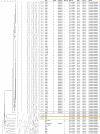Comparative Genotypic and Phenotypic Analysis of Cronobacter Species Cultured from Four Powdered Infant Formula Production Facilities: Indication of Pathoadaptation along the Food Chain
- PMID: 25911470
- PMCID: PMC4475896
- DOI: 10.1128/AEM.00359-15
Comparative Genotypic and Phenotypic Analysis of Cronobacter Species Cultured from Four Powdered Infant Formula Production Facilities: Indication of Pathoadaptation along the Food Chain
Abstract
Cronobacter species are opportunistic pathogens commonly found in the environment. Among the seven Cronobacter species, Cronobacter sakazakii sequence type 4 (ST-4) is predominantly associated with recorded cases of infantile meningitis. This study reports on a 26-month powdered infant formula (PIF) surveillance program in four production facilities located in distinct geographic regions. The objective was to identify the ST(s) in PIF production environments and to investigate the phenotypic features that support their survival. Of all 168 Cronobacter isolates, 133 were recovered from a PIF production environment, 31 were of clinical origin, and 4 were laboratory type strains. Sequence type 1 (n = 84 isolates; 63.9%) was the dominant type in PIF production environments. The majority of these isolates clustered with an indistinguishable pulsotype and persisted for at least an 18-month period. Moreover, DNA microarray results identified two phylogenetic lineages among ST-4 strains tested. Thereafter, the ST-1 and -4 isolates were phenotypically compared. Differences were noted based on the phenotypes expressed by these isolates. The ST-1 PIF isolates produced stronger biofilms at both 28°C and 37°C, while the ST-4 clinical isolates exhibited greater swimming activity and increased binding to Congo red dye. Given the fact that PIF is a low-moisture environment and that the clinical environment provides for an interaction between the pathogen and its host, these differences may be consistent with a form of pathoadaptation. These findings help to extend our current understanding of the epidemiology and ecology of Cronobacter species in PIF production environments.
Copyright © 2015, American Society for Microbiology. All Rights Reserved.
Figures







References
-
- Iversen C, Lehner A, Mullane N, Bidlas E, Cleenwerck I, Marugg J, Fanning S, Stephan R, Joosten H. 2007. The taxonomy of Enterobacter sakazakii: proposal of a new genus Cronobacter gen. nov. and descriptions of Cronobacter sakazakii comb. nov. Cronobacter sakazakii subsp. sakazakii, comb. nov., Cronobacter sakazakii subsp. malonaticus subsp. nov., Cronobacter turicensis sp. nov., Cronobacter muytjensii sp. nov., Cronobacter dublinensis sp. nov. and Cronobacter genomospecies 1. BMC Evol Biol 7:64. doi:10.1186/1471-2148-7-64. - DOI - PMC - PubMed
-
- Iversen C, Mullane N, McCardell B, Tall BD, Lehner A, Fanning S, Stephan R, Joosten H. 2008. Cronobacter gen. nov., a new genus to accommodate the biogroups of Enterobacter sakazakii, and proposal of Cronobacter sakazakii gen. nov., comb. nov., Cronobacter malonaticus sp. nov., Cronobacter turicensis sp. nov., Cronobacter muytjensii sp. nov., Cronobacter dublinensis sp. nov., Cronobacter genomospecies 1, and of three subspecies, Cronobacter dublinensis subsp. dublinensis subsp. nov., Cronobacter dublinensis subsp. lausannensis subsp. nov. and Cronobacter dublinensis subsp. lactaridi subsp. nov. Int J Syst Evol Microbiol 58:1442–1447. doi:10.1099/ijs.0.65577-0. - DOI - PubMed
-
- Joseph S, Cetinkaya E, Drahovska H, Levican A, Figueras MJ, Forsythe SJ. 2012. Cronobacter condimenti sp. nov., isolated from spiced meat, and Cronobacter universalis sp. nov., a species designation for Cronobacter sp. genomospecies 1, recovered from a leg infection, water and food ingredients. Int J Syst Evol Microbiol 62:1277–1283. doi:10.1099/ijs.0.032292-0. - DOI - PubMed
-
- Himelright I, Harris E, Lorch V, Anderson M, Jones T, Craig A, Kuehnert M, Forster T, Arduino M, Jensen B, Jernigan D. 2002. Enterobacter sakazakii infections associated with the use of powdered infant formula—Tennessee, 2001. MMWR Morb Mortal Wkly Rep 51:297–300. - PubMed
MeSH terms
LinkOut - more resources
Full Text Sources
Medical
Molecular Biology Databases

